The Asus NUC 14 Pro is one of the most customizable mini PCs I’ve tested yet, with loads of different configuration options to meet a variety of workflows. You can choose between a slim or a tall case and it’s also available in a barebones configuration, along with a standard one where you don’t have to buy your memory and storage separately. Regardless of which route you go, you then have five different Intel-based processor options to pick from.
Despite the NUC 14 Pro’s absolutely tiny size (it’s even smaller than the Mac mini M4), Asus has managed to cram this mini PC full of ports, though it is missing one particularly useful one. It’s also one of the few mini PCs with not one, but two Thunderbolt 4 ports and if you go with the tall case, you can get third-party expansion brackets to add even more ports around back. Depending on how you configure the NUC 14 Pro though, things can get expensive quickly. Likewise, its fan can be a bit on the noisy side when the system is under heavy load.
My Asus NUC 14 Pro review will help you decide if this is the best mini PC for you or if you’d be better off buying something less customizable but more affordable.
Asus NUC 14 Pro: Cheat sheet
- What is it? A customizable mini PC that’s available in a short or tall chassis.
- Who is it for? Business users or professionals that want a powerful yet small workstation that they can configure to their workflow.
- What does it cost? The Asus NUC 14 Pro can cost as little as $400 in a barebones configuration without memory and storage, but it can go all the way up to $1,000 depending on which processor you choose.
- What do we like? The port configuration, the extra M.2 or 2.5-inch drive bay, the wide range of processor options, and its very small size.
- What don’t we like? There’s no 3.5mm audio jack, its fan can get noisy under load, and depending on how you configure your system, this mini PC can be very expensive.
Asus NUC 14 Pro: Specs
Swipe to scroll horizontally
| Price | $394-$899 (barebone), $848 (tall chassis, Core Ultra 5, 16GB RAM, 512GB SSD) $993 (tall chassis, Core Ultra 7, 32GB RAM, 1TB SSD) | $900 |
| CPU | Intel Core Ultra 3 100UIntel Core Ultra 5 125HIntel Core Ultra 5 135H with vProIntel Core Ultra 7 155HIntel Intel Core Ultra 7 165H with vPro | Intel Core Ultra 7 165H with vPro |
| GPU | Intel Graphics (Core 3)Intel Arc Graphics (Core Ultra) | Intel Arc Graphics |
| RAM | 16-32GB DDR5 | 16GB DDR5 |
| Storage | 512GB-1TB, 1 x M.2 slot | 512GB, 1 x M.2 slot, 1 x 2.5” bay |
| Ports | 1 x USB-C, 2 x USB-A (front), Kensington Lock (side), 2 x USB-C, 2 x USB-A, 2 x HDMI, 1 x 2.5G Ethernet (rear) | 1 x USB-C, 2 x USB-A (front), Kensington Lock (side), 2 x USB-C, 2 x USB-A, 2 x HDMI, 1 x 2.5G Ethernet (rear) |
| Connectivity | Wi-Fi 6E, Bluetooth 5.3 | Wi-Fi 6E, Bluetooth 5.3 |
| Size | 4.6 x 4.41 x 1.45 (slim), 4.61 x 4.41 x 2.13 (tall) | 4.61 x 4.41 x 2.13 (tall) |
| Weight | 1.1-1.32 pounds | 1.32 pounds |
Asus NUC 14 Pro: The ups
The Asus NUC 14 Pro can easily be tailored for most workflows thanks to the numerous configuration options available with multiple processors to choose from. Despite its small size, it also packs plenty of ports, along with a spare M.2 slot and even a 2.5-inch bay for a hard drive or SSD. There’s also a rear expansion slot to add even more ports if you opt for the tall chassis.
Configurations galore
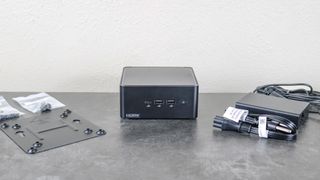
Normally with most mini PCs, you have a few processor options to choose from, along with two options for your RAM (16GB or 32GB) and storage (512GB or 1TB). With the Asus NUC 14 Pro, not only can you pick from five different Intel processors (one Core 3, four Core Ultra), you also get to choose between a slim or a tall chassis. Alternatively, you can buy a barebones version of this mini PC in either size and buy your memory and storage separately. If you’re upgrading from an older Intel NUC, you’ll surely appreciate all of these options. However, if this is your first mini PC, you might be a tad intimidated by all the choices it offers.
The configuration of the NUC 14 Pro from Asus that I tested has a tall chassis, an Intel Core Ultra 7 165H processor with Intel Arc Graphics, 16GB of DDR5 RAM, and a 512GB SSD. Even with just 16GB of RAM, I’ve been able to have dozens of Chrome tabs open in multiple windows and quickly edit photos in GIMP. In fact, I used it as my main computer while covering Black Friday and it never missed a beat.
As the Asus NUC 14 Pro is more geared toward productivity and designed for business users, the integrated Intel Arc Graphics aren’t really for gaming. Still, in Sid Meier’s Civilization VI, it managed to hit 36 fps at 1080p. You might be able to play some older titles on the NUC 14 Pro, but if you want a mini PC from Asus primarily for gaming, the ROG NUC 970 is a much better, though more expensive choice.
Swipe to scroll horizontally
| Geekbench 6.3 single-core | 2512 | 2271 |
| Geekbench 6.3 multi-core | 12368 | 11170 |
| 25GB file copy test (MBps) | 1502.38 | 1176.49 |
| Handbrake (Mins:Secs) | 4:28 | 4:41 |
A tiny multi-monitor workstation
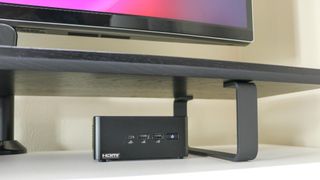
Even though the NUC 14 Pro is actually smaller than Apple’s new Mac mini M4, Asus didn’t skimp out on ports. On the front, you get two USB Type-A ports along with a USB Type-C port. The Mac mini M4 does have one port on the front that you won’t find on the NUC 14 Pro, but more on that later.
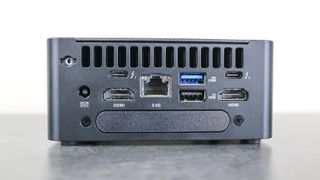
Around back, there are two USB Type-A ports, two HDMI 2.1 ports, two Thunderbolt 4 ports, a 2.5G Ethernet port, and a power port for the NUC 14 Pro’s barrel jack power connector. It’s worth noting that you get the exact same port selection regardless of whether you go with the slim or tall chassis.
With dual HDMI and dual Thunderbolt ports, you can actually run four of the best monitors off of this tiny little mini PC. That’s one more than on the Mac mini M4, and since you have HDMI as well as Thunderbolt, you won’t need any special adapters or a more expensive monitor with USB-C input to easily power a dual monitor setup.
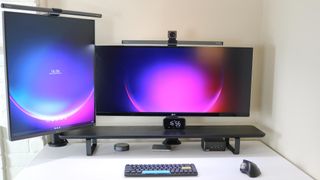
While I normally use an ultrawide monitor as my main display with a portable monitor underneath it, I decided to do something different with the NUC 14 Pro to utilize both HDMI ports. To the right of my ultrawide, I set up the LG DualUp monitor so that I can have a vertical display next to my main one to see full-size webpages and documents without having to scroll.
Expandable storage and even ports
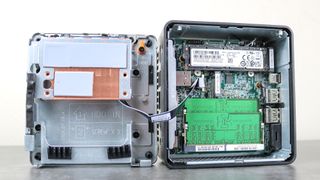
One of my favorite things about the ROG NUC 970 is that it has two spare M.2 slots. Despite being much smaller, Asus has done something similar with the NUC 14 Pro. However, the tall chassis is the better option if you plan on adding multiple drives.
With the NUC 14 Pro’s slim chassis, you only get one extra M.2 slot (2242). However, with the extra space in the tall chassis, you can also add a 2.5-inch HDD or SSD on the bottom along with an extra M.2 SSD.
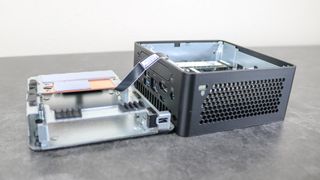
Opening the NUC 14 Pro can be tricky the first time, but once you get the hang of it, it’s fairly easy to do. You just need to be careful with the ribbon cable that connects the 2.5-inch bay to the motherboard. Asus claims the NUC 14 Pro has a tool-free design, but I found I needed to use a coin or better yet, a flat-head screwdriver to get the case open.
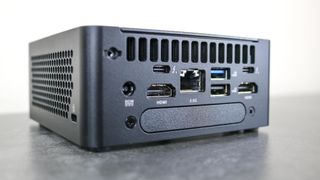
Another interesting thing about Asus’ NUC line of mini PCs is that there’s a whole third-party ecosystem of accessories for them. For instance, I found a company called GORITE that sells expansion brackets and lid replacements that can be used to add extra USB ports or even antennas to the NUC 14 Pro with a tall chassis. This probably won’t be for everyone, but it could be very useful if you want to configure this mini PC for more specialized workflows after the fact.
Asus NUC 14 Pro: The downs
The Asus NUC 14 Pro almost has every port you’d need on the front and the back, but it’s missing one port in particular that comes standard on every other mini PC. Likewise, its internal fan can get noisy when the system is under heavy load.
No audio jack
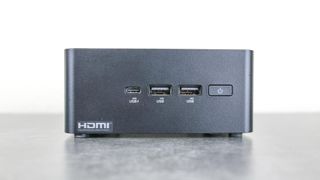
After trying out the Mac mini M2 and then the Mac mini M4 right after it, I really came to appreciate its front ports. Besides the two USB-C ports at the front, you also get a 3.5mm audio jack for quickly connecting wired headphones. It took me a while to notice as I either use my monitor’s built-in speakers or a pair of the best computer speakers connected via USB, but on the NUC 14 Pro, there’s no 3.5mm audio jack on the back either.
While this won’t be a deal breaker for most people, it’s a shame that Asus decided to not add a headphone jack to the NUC 14 Pro. There’s a bit of space next to the USB-C port on the front or above the power port on the back where a 3.5mm audio jack would fit perfectly. This can easily be fixed with a USB-to-3.5mm adapter, but one of the reasons to get a Windows-based mini PC over one from Apple is so that you don’t have to deal with dongles.
Noisy under load
During the weeks I’ve spent testing the NUC 14 Pro, it’s been very quiet for the most part. However, when I had a lot of programs open at once or a very RAM-hungry Chrome tab, I did hear the fan spin up occasionally. It’s loud enough that it can be distracting, but once again, this isn’t a deal breaker by any means.
If you’re looking for a cheaper alternative and don’t mind the extra noise, the Acemagic F2A also comes equipped with an Intel Core Ultra processor. Unfortunately, its dual fans spin almost constantly, and during testing, they got as loud as 55db. Meanwhile, the NUC 14 Pro’s single fan reached a max noise level of 50db when under load.
Asus NUC 14 Pro: Verdict
The Asus NUC 14 Pro is a highly customizable little workstation that delivers where it counts. This mini PC is fast, comes equipped with plenty of ports, and you can even add more storage if need be. I really like the fact that it’s available with either a slim or tall chassis and even the larger one isn’t all that big at just 4.61 x 4.41 x 2.13 inches.
Depending on how you can configure the NUC 14 Pro, it can cost up to $1,000 or as little as $400 if you go with the barebones option and a less powerful CPU. Still, it’s nice to have options, especially if you want to purchase multiple NUC 14 Pros for a business or an office. The third-party bracket and lid customization options are also nice to have, even if the stock configuration is good enough for most people.
If you want a powerful and expandable mini PC from a more well-known brand for work and don’t want to switch to macOS, the NUC 14 Pro is a great choice. However, if this is your first mini PC, all of the options might be a tad overwhelming.











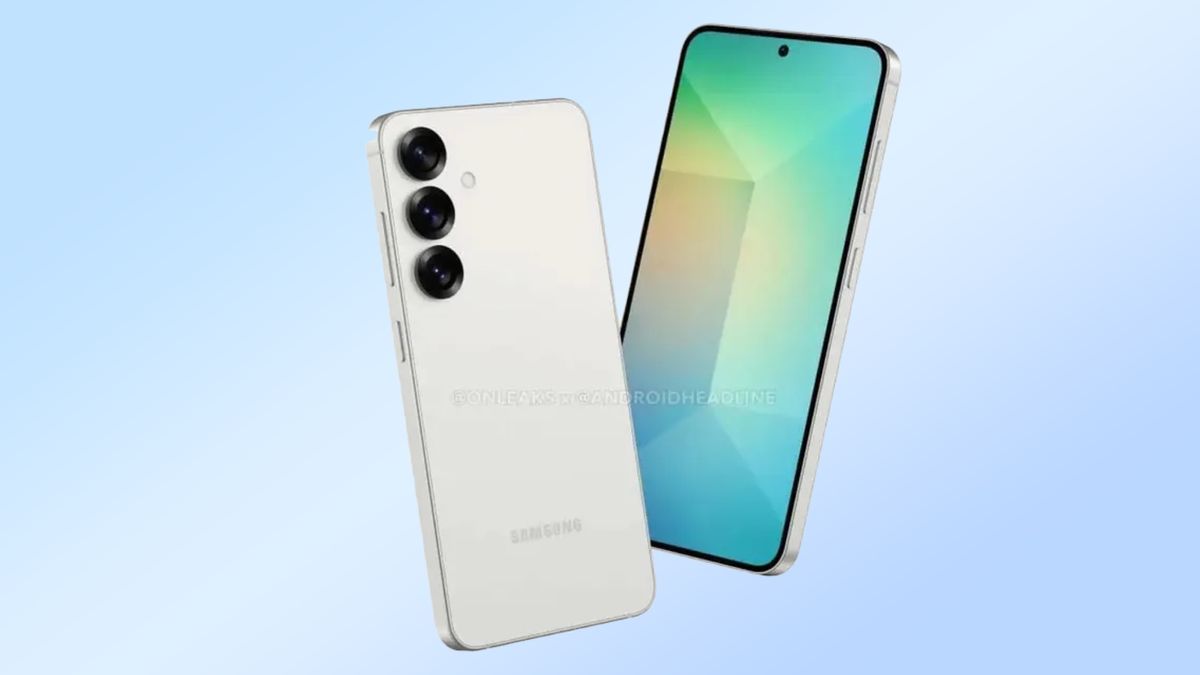









 English (US) ·
English (US) ·